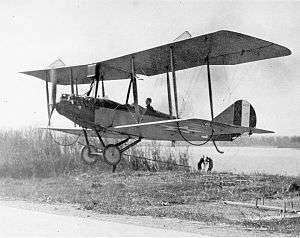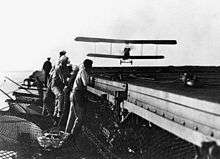Aeromarine 39
| Aeromarine 39 | |
|---|---|
 | |
| Role | Land or water-based trainer |
| Manufacturer | Aeromarine Plane and Motor Company |
| Primary user | United States Navy |
| Number built | 150 |
|
| |
The Aeromarine 39 was an American two-seat training seaplane ordered by the US Navy in 1917 and built by the Aeromarine Plane and Motor Company of Keyport, New Jersey. Of conventional biplane configuration and construction, the aircraft was designed so that its pontoons could be speedily detached and replaced with wheeled undercarriage for shore operations.
History
Fifty of the original design (later referred to as the 39A) were produced, featuring twin floats and powered by a Hall-Scott A-7 engine. A redesign followed, increasing the wingspan to create more lift for water take-offs. This became known as the 39B. Other changes included a change to a single pontoon with outrigger floats, an enlarged vertical tail, and a change of powerplant to the Curtiss OXX.
On October 26, 1922 Godfrey DeCourcelles Chevalier landed a 39B on a moving ship, USS Langley, the first time this had been achieved on an American aircraft carrier. Trials of underway carrier takeoffs and landings continued through 1922 and 1923.
Survivors
An example of a 39B is preserved at the Old Rhinebeck Aerodrome, although it has been severely damaged by two fires, one in 1966 and one in the early 1980s.
Operators
Specifications (Aeromarine 39B)

General characteristics
- Length: 30 ft 4¼ in (9.25 m)
- Wingspan: 47 ft 0 in (14.32 m)
- Height: 13 ft 2 in (4.01 m)
- Wing area: 494 ft² (45.89 m²)
- Empty weight: 1,939 lb (880 kg)
- Loaded weight: 2,050 lb (931 kg)
- Max. takeoff weight: 2,505 lb (1136 kg)
- Powerplant: 1 × Curtiss OXX-6 Vee piston, 100 hp (75 kW)
Performance
- Maximum speed: 73 mph (117 km/h)
- Range: 273 miles (439 km)
- Service ceiling: 8,200 ft (2,500 m)
- Power/mass: 0.049 hp/lb (80 W/kg)
References
- The Illustrated Encyclopedia of Aircraft (Part Work 1982-1985). Orbis Publishing.
External links
![]() Media related to Aeromarine 39 at Wikimedia Commons
Media related to Aeromarine 39 at Wikimedia Commons